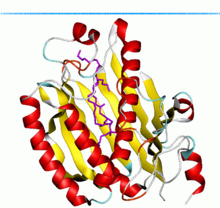Biology:Phosphatidylinositol transfer protein
 Phosphatidylinositol transfer protein, beta isoform | |||||||||
| Identifiers | |||||||||
|---|---|---|---|---|---|---|---|---|---|
| Symbol | IP_trans | ||||||||
| Pfam | PF02121 | ||||||||
| InterPro | IPR001666 | ||||||||
| SCOP2 | 1fvz / SCOPe / SUPFAM | ||||||||
| OPM superfamily | 138 | ||||||||
| OPM protein | 2a1l | ||||||||
| CDD | cd07815 | ||||||||
| |||||||||
Phosphatidylinositol transfer protein (PITP) or priming in exocytosis protein 3 (PEP3) is a ubiquitous cytosolic domain involved in transport of phospholipids from their site of synthesis in the endoplasmic reticulum and Golgi to other cell membranes.[1][2]
Biological function
PITP has been also shown to be an essential component of the polyphosphoinositide synthesis machinery and is hence required for proper signalling by epidermal growth factor and f-Met-Leu-Phe, as well as for exocytosis. The role of PITP in polyphosphoinositide synthesis may also explain its involvement in intracellular vesicular traffic.[1]
Structure and evolution
Along with the structurally unrelated Sec14p family (found in Pfam PF00650), this family can bind/exchange one molecule of phosphatidylinositol (PI) or phosphatidylcholine (PC) and thus aids their transfer between different membrane compartments. There are three sub-families - all share an N-terminal PITP-like domain, whose sequence is highly conserved. It is described as consisting of three regions. The N-terminal region is thought to bind the lipid and contains two helices and an eight-stranded, mostly antiparallel beta-sheet. An intervening loop region, which is thought to play a role in protein-protein interactions, separates this from the C-terminal region, which exhibits the greatest sequence variation and may be involved in membrane binding. This motif marks PITP as part of the larger SRPBCC (START/RHOalphaC/PITP/Bet v1/CoxG/CalC) domain superfamily.[citation needed]
PITP alpha (UniProt Q00169) has a 16-fold greater affinity for PI than PC. Together with PITP beta (UniProt P48739), it is expressed ubiquitously in all tissues.[3]
Human proteins
The family of human phosphatidylinositol transfer proteins has several members:
- Phosphatidylinositol transfer protein, alpha (PITPNA)
- Phosphatidylinositol transfer protein, beta (PITPNB)
- Phosphatidylinositol transfer protein, cytoplasmic 1 (PITPNC)
- Phosphatidylinositol transfer protein, membrane-associated 1 (PITPNM1)
- Phosphatidylinositol transfer protein, membrane-associated 2 (PITPNM2)
- PITPNM family member 3 (PITPNM3)
References
- ↑ 1.0 1.1 "Signal transduction and membrane traffic: the PITP/phosphoinositide connection". Cell 81 (5): 659–662. 1995. doi:10.1016/0092-8674(95)90525-1. PMID 7774006.
- ↑ "Phosphatidylinositol transfer protein required for ATP-dependent priming of Ca(2+)-activated secretion". Nature 366 (6455): 572–5. December 1993. doi:10.1038/366572a0. PMID 8255295. Bibcode: 1993Natur.366..572H.
- ↑ "The PITP family of phosphatidylinositol transfer proteins". Genome Biol. 2 (9): REVIEWS3011. 2001. doi:10.1186/gb-2001-2-9-reviews3011. PMID 11574064.
 |

